What Parts of New Orleans Were Built Again After Katrian
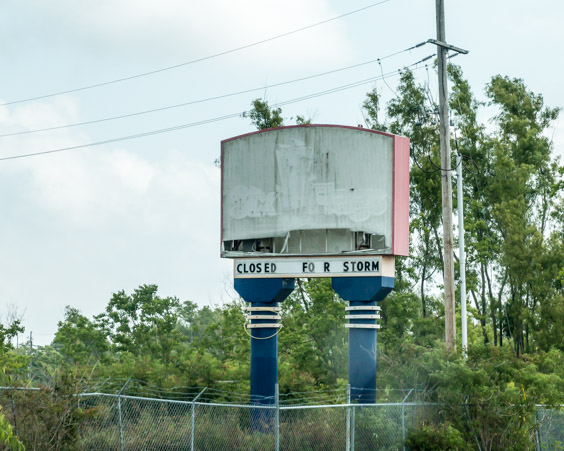
Thirteen years ago, Hurricane Katrina ready into motion a series of events that resulted in the deaths of 1,800 people. Levees broke, the city was inundated and inefficient bureaucracy crippled relief efforts.
When the storm was over and the waters receded, volunteers from all over the country descended on the area, determined to aid the metropolis and it'due south people rebuild. Our daughter, Laura, was one of those volunteers.
In 2004, our family unit took a road trip which included a stop in New Orleans. Nosotros enjoyed a narrated carriage ride, walked the French Quarter, went to Mardi Gras Earth and visited the plantations along the River Route. One year later, on August 23rd, 2005, Hurricane Katrina brought devastation to the city. It wasn't until the summertime of 2006, that volunteers, were allowed to help clean out homes.
Simpson Academy in Redding, California sent a group of it'south students to help and Laura went along.
A few of her pictures from this volunteer trip.



Every house needed to be completely gutted. The oil and chemicals which polluted the waters had contaminated the buildings. The college students worked hard, cleaning out one business firm at a time. After, they made a second trip bringing in nutrient and donations.
Laura wanted so desperately to aid where she could. She shared her love of the people and the city with us often. When we finally had a chance to visit once more we were hoping to share with her how the city had recovered. It was also of import to us to be able to pay our respects to those who were lost.
Today, I've mapped out a driving trip through some of the most devastated areas every bit well equally National Parks and tourist spots.
We're staying in Pass Christian Mississippi. Our route takes us across the I-10 twin span span, over the bay of Lake Pontchartrain.
The I-x bridge was heavily damaged after Katrina (lensman unknown).

This is our view of information technology today, a cute new roadway.

One of the first things I wanted to see was whether Six Flags New Orleans was withal there. I heard rumors that some of it had been dismantled.
As we approach, information technology's clear the park is still abandoned and the rides remain. The skeleton of the roller coaster is visible from the freeway.



From a distance, you tin can virtually believe the park is notwithstanding operating. In one case you turn onto Six Flags Parkway though, the illusion is shattered.
The storm sign yet stands thirteen years later on.

The parking lot is around the back of the park. The entrance is guarded by a security vehicle. The back mural is a swamp, the ghostly ferris wheel visible in the altitude.

Another loop around the front and the ferris bike comes into view.

Every bit of June of this year, the new mayor has been given one year in order to try and find redevelopment for the belongings. This article link explains the agreement and shows some incredible drone footage of the park.
Our tour continues down highway 510 to 47 into Chalmette and a steep bridge.

With an incredible view of the city.


Our adjacent stop is Chalmette National Cemetery and Battlefield. This is a National Park Passport postage stamp site and we're anxious to see how information technology has fared since Katrina.

The impairment to this park was severe. The company center was completely destroyed, the historic cemetery wall was heavily damaged and coffins and soldiers basic surfaced in the flood waters.
Today in that location is a brand new visitor center, full of artifacts and data about the Battle of New Orleans.

Chalmette battlefield is the site of the last keen battle of the war of 1812, as well known every bit the battle of New Orleans. On January 8, 1815, Andrew Jackson's hastily assembled army won the day, against a boxing hardened and numerically superior British force. Americans took great pride in the victory and for decades celebrated Jan 8th equally a national vacation.


Can you shoot a musket?

Battlefield artifacts.



The visitor center provided an interesting docent lecture on the lawn. We were joined by a group of passengers from a New Orleans paddlewheel prowl.
The docent told how Jacksons army of rag-tag, backwoods sharpshooters, complimentary men of colour and swashbuckling buccaneers, won the battle using excavation, canals and other defenses.


The battlefield itself is a large expanse of open state. There is a driving loop of the battleground but we are pressed for time today and opt out.
The cemetery can also be toured.

The land was originally a plantation.
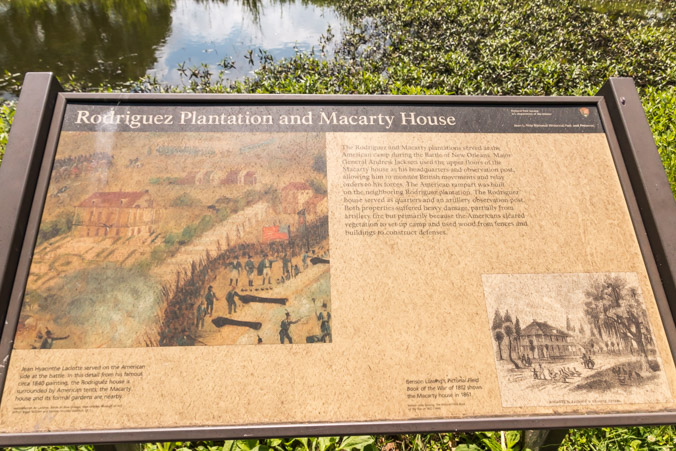

There is one edifice remaining, right on the banks of the Mississippi.
The Malus-Beauregard House. The interior of the business firm was flooded 2-three feet during Katrina. We were told it has been restored but is currently airtight.



The house faces the Mississippi and the paddlewheel boat parks at the dock there. Periodically, huge cargo ships prowl by while bravado their horns.

Hidden away, in the far corner of the country, is a pocket-size memorial marker.
It says "In retention of Samuel Spotts, the homo who shot the first gun at the battle of New Orleans."

It's been an interesting visit merely information technology'southward time to move on to the next destination.
A bulldoze through the Lower 9th Ward.
We did't make it very far before traffic was stopped for some police action.
Their guns are fatigued.

I'thousand astounded at the number of people nearby, casually watching.

There are no less than 2 guns fatigued, perchance multiple suspects but the matter is resolved quickly and traffic period resumes. Crime is alive and well hither.
Equally we enter the Lower Ninth Ward, it'due south a ghost town. There are hundreds of empty lots where houses one time stood, and many derelict houses which notwithstanding show damage.


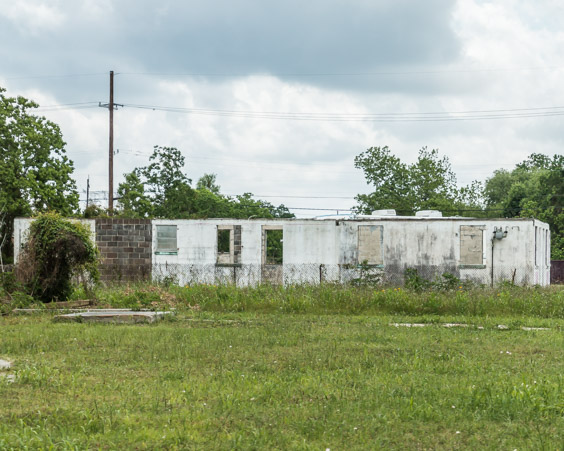
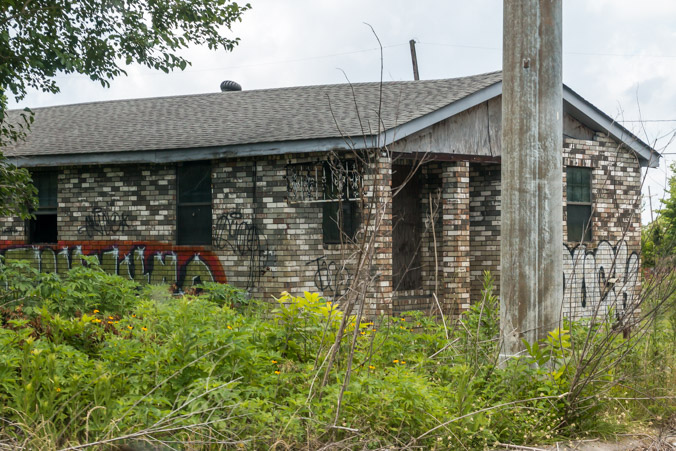
Equally nosotros approach the upper corner of the neighborhood, we meet levees, pump houses and pipes. This is the first time I've seen the technology and infrastructure which keeps the h2o out of the basin that is New Orleans.
It's a huge undertaking.


Seeing information technology in person has given me a new appreciation for the complexity of the job.

This sign marks the spot where the offset levee failed in the Lower Ninth Ward.
My centre breaks for the people who lived through this nightmare.

The loftier water marks can still be seen on some of the houses.

After Hurricane Katrina, actor Brad Pitt built dozens of new homes for residents of the Lower Ninth Ward. He operated under the umbrella of an organization chosen Brand it Right Foundation. In the offset, in that location were complaints that the modern firm styles didn't fit in with the historical styles of New Orleans. Years after, there were complaints that the houses were built cheaply and they are at present falling apart.
I saw quite a few that had a lot of damage and I was surprised to discover out that they were the new houses, not the quondam. These 2 are a piffling better than about.
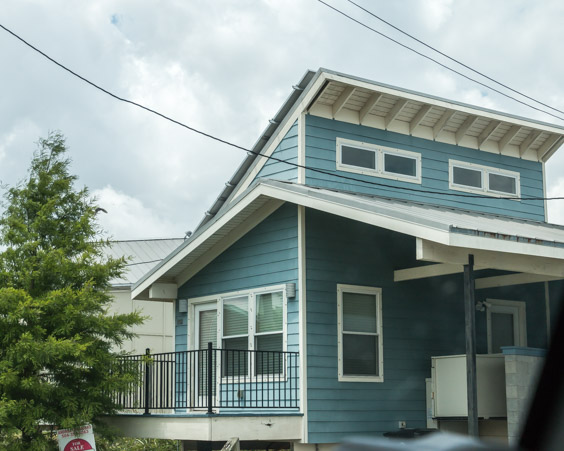

They definitely don't fit into the style of the neighborhood.

When planning this driving tour, I was using Google maps, satellite view. During 1 of my "spying" sessions, I noticed a huge edifice near the river whose roof seemed to be damaged. I discovered in my inquiry that the building was the Holy Cross Schoolhouse built in 1895. Information technology was a beautiful building and similar so many others I was afraid it might be demolished.
I wanted to see it before it was lost.


It suffered extensive damage during the hurricane and has been allowed to deteriorate. Information technology'due south beautiful Italianate architecture is marred by graffiti, weeds and old pieces of tarp. There is talk of a redevelopment project for the building and a neighborhood association seeks to protect it. It'south discouraging to note that zilch has been done to salvage it in 13 years time. At that place is one, small, encouraging sight though. When I looked at contempo satellite images, a brand new tarp is covering the roof at present.
Effectually the corner stands another old, neglected edifice,
The Thomas J Semmes schoolhouse, dedicated in 1901.

It's also covered in graffiti but seems to have been recently boarded upwardly. I tin can't detect much information most the building except that it was scheduled to be auctioned by the Sheriffs department in Apr 2017. The sale was postponed and I plant no information on the sale. I did, however, find an sometime article, involving a politician who illegally diverted FEMA funds in 2012. Funds which were earmarked to refurbish the building.
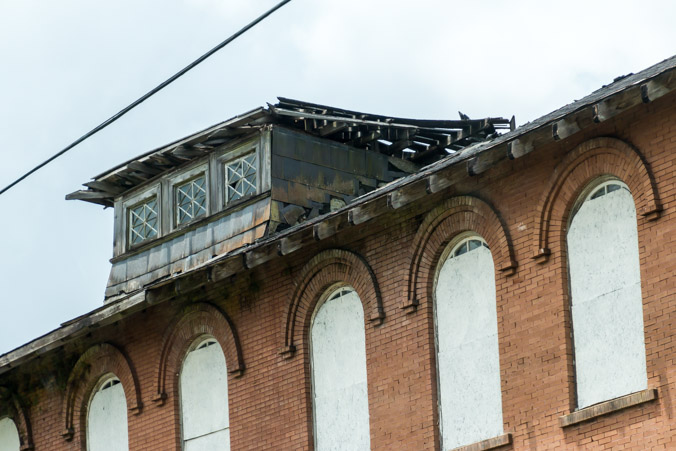
The political corruption and ineptitude during and afterwards this disaster, are so outrageous as to be nearly unbelievable. If you want to learn more, I highly recommend the volume "The Great Drench" by Douglas Brinkley.
It will suspension your heart.
So far, nosotros've seen a lot of lingering damage.
One of the most shocking sights was a consummate storage facility with doors popped open, ruined belongings spilling out. Information technology even so sits there xiii years later. Did the owner but walk abroad from it? Who owns it and who's responsible for cleaning information technology upwards?
We saw lot, afterward lot, afterwards lot, of smashed cars which were salvaged from the waters. I've never seen and so many smashed cars. I guess it never occurred to me how many cars would be lost in a disaster like Katrina. What do you do with all of them? They're still sitting in towering piles scattered around the city.
Rust, graffiti, mold and trash. In this part of town, and so much was lost. Homes were destroyed, people died or moved away, never to return. There are a few pockets of hope, people hanging on, trying to bring life dorsum to the neighborhood. Nosotros saw a houses existence refurbished, new siding, new paint, flowers planted in boxes. Businesses are open and life goes on. It may never be the aforementioned, but I promise that the residents tin can make a good life there again.
This ends function one of our New Orleans bout.
Stay tuned for role 2!
Source: https://nostoneunturnedadventures.com/2018/11/29/new-orleans-13-years-after-katrina-part-one/
0 Response to "What Parts of New Orleans Were Built Again After Katrian"
Post a Comment